Alliance Contracts: Comparison, Benefits, and Real-World Applications
VerifiedAdded on 2023/02/01
|7
|1350
|79
Report
AI Summary
This report provides a comprehensive overview of alliance contracts, contrasting them with traditional contracts and examining the circumstances under which they are chosen. It highlights the key features of alliance contracts, such as their focus on incentive-based relationships, cooperative decision-making, risk-sharing, and financial transparency, which aim to align the business goals of all parties involved. The report explores real-world examples, including the Perth desalination plant and wastewater treatment plant projects, to illustrate the practical application and benefits of alliance contracts, particularly in complex projects like those in the construction industry. It also details the advantages, such as active project management, reduced costs, and improved quality, as well as the disadvantages, including dependence on personal commitment and potential for complacency. The report concludes by emphasizing the increasing relevance of alliance contracts, especially in fostering trust and shared responsibility, and their role in mitigating the drawbacks of traditional models.
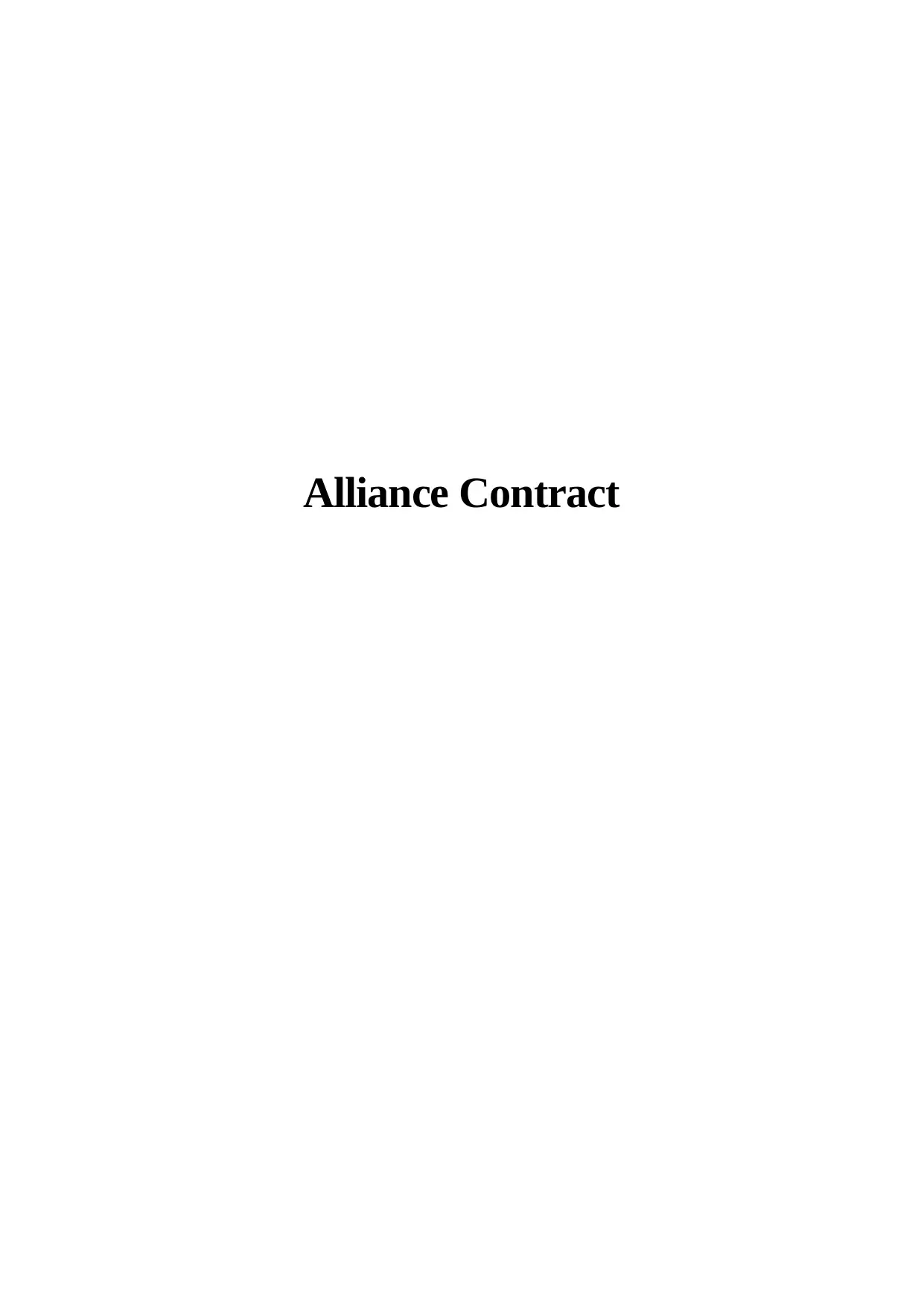
Alliance Contract
Paraphrase This Document
Need a fresh take? Get an instant paraphrase of this document with our AI Paraphraser
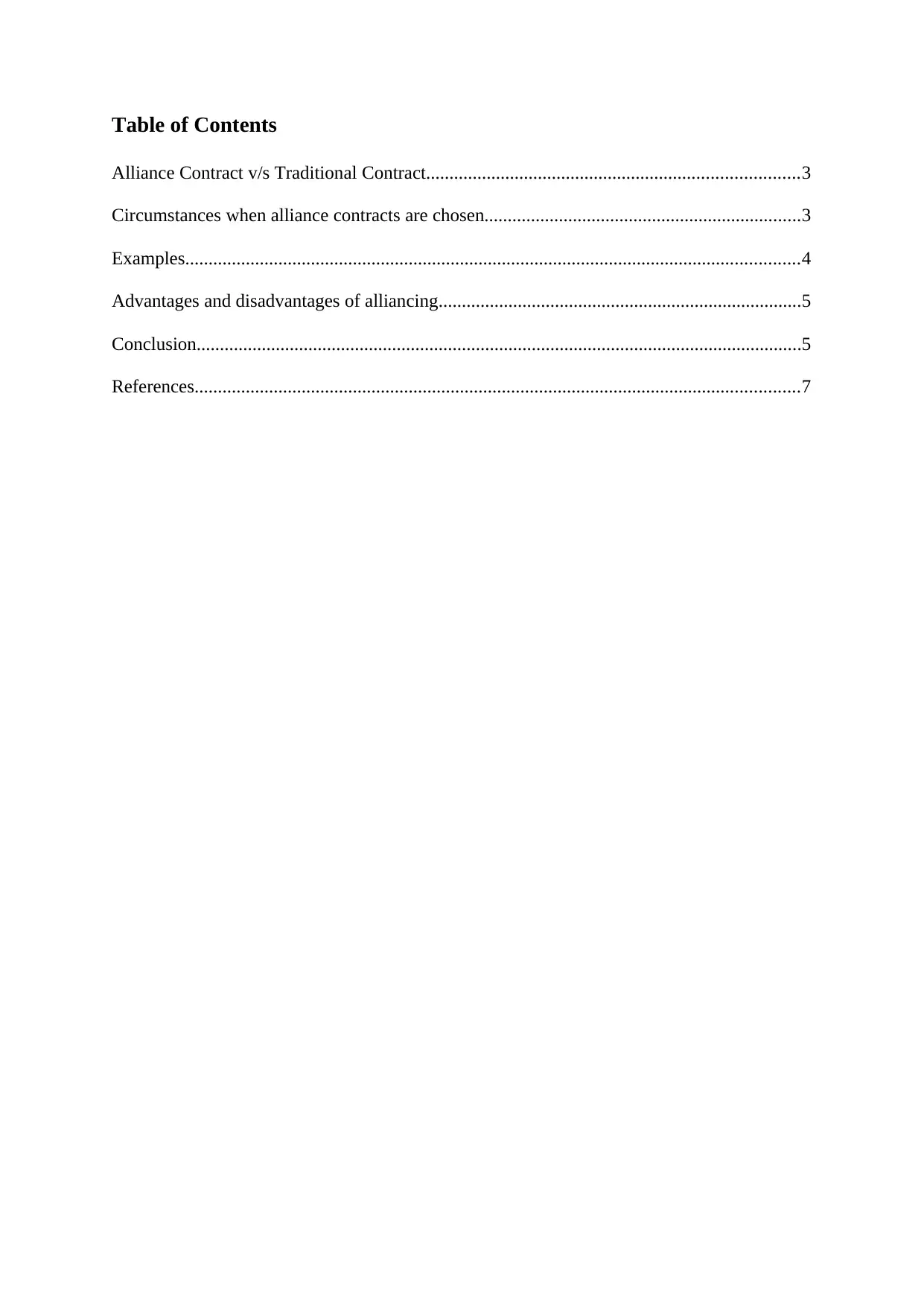
Table of Contents
Alliance Contract v/s Traditional Contract................................................................................3
Circumstances when alliance contracts are chosen....................................................................3
Examples....................................................................................................................................4
Advantages and disadvantages of alliancing..............................................................................5
Conclusion..................................................................................................................................5
References..................................................................................................................................7
Alliance Contract v/s Traditional Contract................................................................................3
Circumstances when alliance contracts are chosen....................................................................3
Examples....................................................................................................................................4
Advantages and disadvantages of alliancing..............................................................................5
Conclusion..................................................................................................................................5
References..................................................................................................................................7
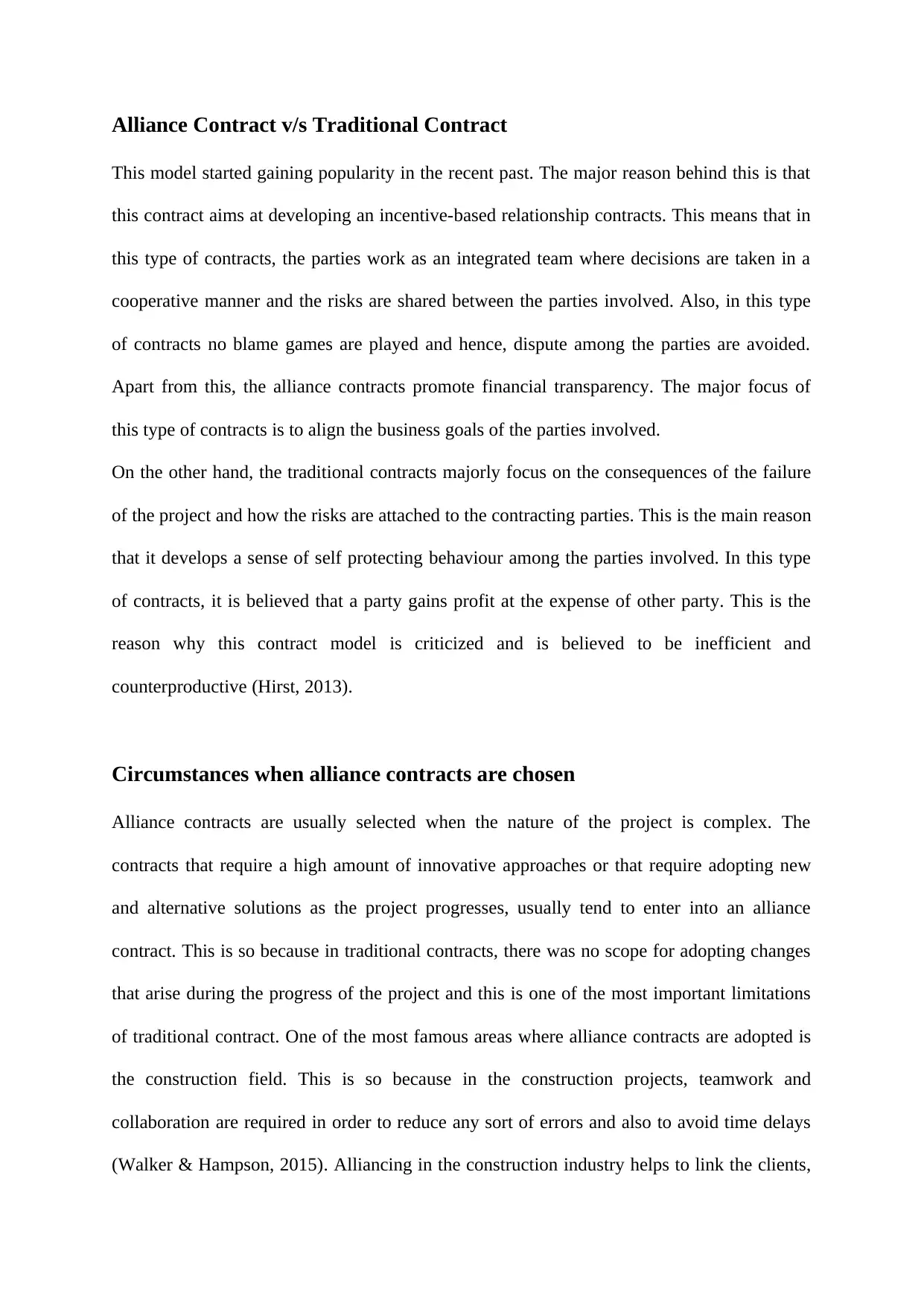
Alliance Contract v/s Traditional Contract
This model started gaining popularity in the recent past. The major reason behind this is that
this contract aims at developing an incentive-based relationship contracts. This means that in
this type of contracts, the parties work as an integrated team where decisions are taken in a
cooperative manner and the risks are shared between the parties involved. Also, in this type
of contracts no blame games are played and hence, dispute among the parties are avoided.
Apart from this, the alliance contracts promote financial transparency. The major focus of
this type of contracts is to align the business goals of the parties involved.
On the other hand, the traditional contracts majorly focus on the consequences of the failure
of the project and how the risks are attached to the contracting parties. This is the main reason
that it develops a sense of self protecting behaviour among the parties involved. In this type
of contracts, it is believed that a party gains profit at the expense of other party. This is the
reason why this contract model is criticized and is believed to be inefficient and
counterproductive (Hirst, 2013).
Circumstances when alliance contracts are chosen
Alliance contracts are usually selected when the nature of the project is complex. The
contracts that require a high amount of innovative approaches or that require adopting new
and alternative solutions as the project progresses, usually tend to enter into an alliance
contract. This is so because in traditional contracts, there was no scope for adopting changes
that arise during the progress of the project and this is one of the most important limitations
of traditional contract. One of the most famous areas where alliance contracts are adopted is
the construction field. This is so because in the construction projects, teamwork and
collaboration are required in order to reduce any sort of errors and also to avoid time delays
(Walker & Hampson, 2015). Alliancing in the construction industry helps to link the clients,
This model started gaining popularity in the recent past. The major reason behind this is that
this contract aims at developing an incentive-based relationship contracts. This means that in
this type of contracts, the parties work as an integrated team where decisions are taken in a
cooperative manner and the risks are shared between the parties involved. Also, in this type
of contracts no blame games are played and hence, dispute among the parties are avoided.
Apart from this, the alliance contracts promote financial transparency. The major focus of
this type of contracts is to align the business goals of the parties involved.
On the other hand, the traditional contracts majorly focus on the consequences of the failure
of the project and how the risks are attached to the contracting parties. This is the main reason
that it develops a sense of self protecting behaviour among the parties involved. In this type
of contracts, it is believed that a party gains profit at the expense of other party. This is the
reason why this contract model is criticized and is believed to be inefficient and
counterproductive (Hirst, 2013).
Circumstances when alliance contracts are chosen
Alliance contracts are usually selected when the nature of the project is complex. The
contracts that require a high amount of innovative approaches or that require adopting new
and alternative solutions as the project progresses, usually tend to enter into an alliance
contract. This is so because in traditional contracts, there was no scope for adopting changes
that arise during the progress of the project and this is one of the most important limitations
of traditional contract. One of the most famous areas where alliance contracts are adopted is
the construction field. This is so because in the construction projects, teamwork and
collaboration are required in order to reduce any sort of errors and also to avoid time delays
(Walker & Hampson, 2015). Alliancing in the construction industry helps to link the clients,
⊘ This is a preview!⊘
Do you want full access?
Subscribe today to unlock all pages.

Trusted by 1+ million students worldwide
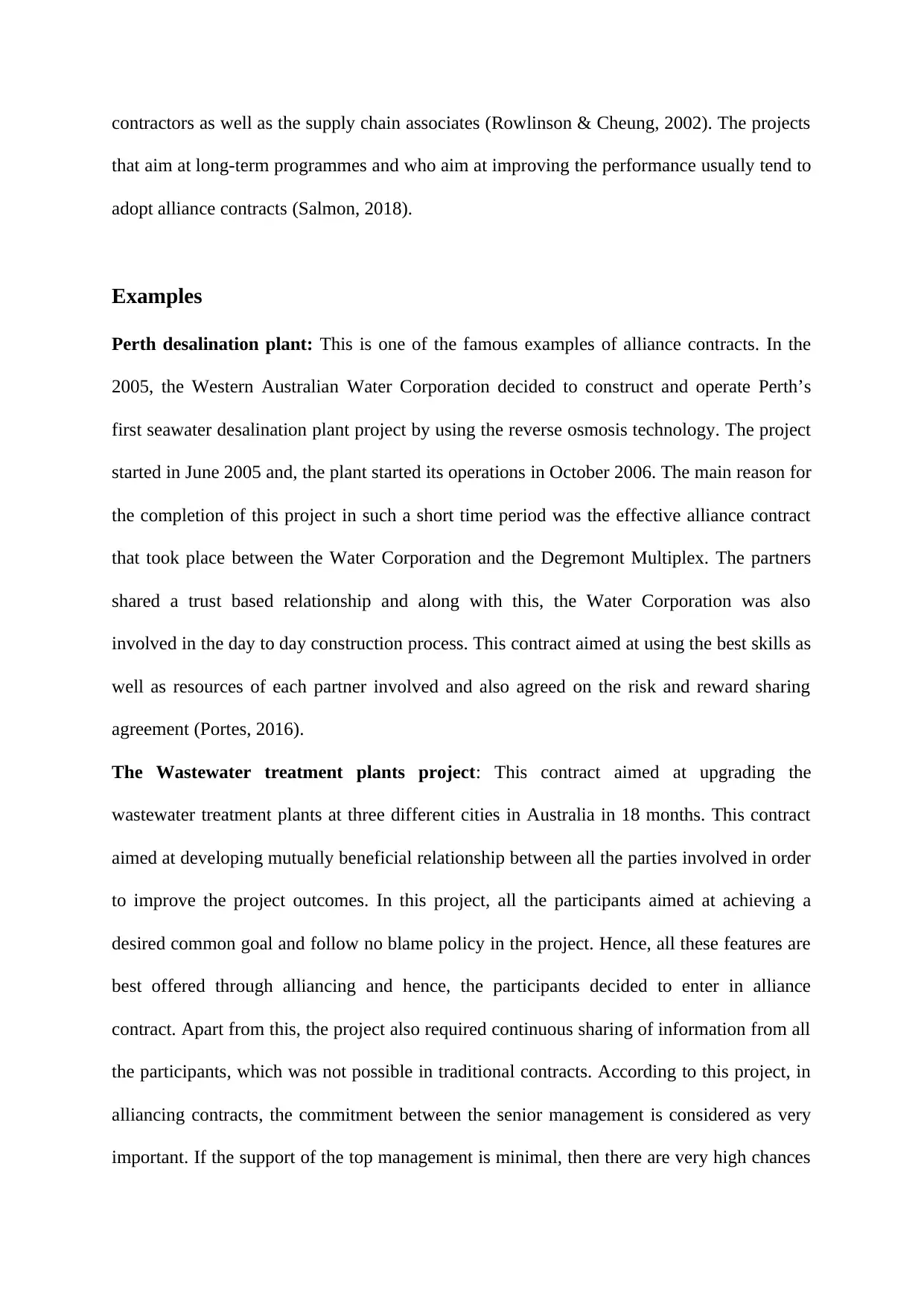
contractors as well as the supply chain associates (Rowlinson & Cheung, 2002). The projects
that aim at long-term programmes and who aim at improving the performance usually tend to
adopt alliance contracts (Salmon, 2018).
Examples
Perth desalination plant: This is one of the famous examples of alliance contracts. In the
2005, the Western Australian Water Corporation decided to construct and operate Perth’s
first seawater desalination plant project by using the reverse osmosis technology. The project
started in June 2005 and, the plant started its operations in October 2006. The main reason for
the completion of this project in such a short time period was the effective alliance contract
that took place between the Water Corporation and the Degremont Multiplex. The partners
shared a trust based relationship and along with this, the Water Corporation was also
involved in the day to day construction process. This contract aimed at using the best skills as
well as resources of each partner involved and also agreed on the risk and reward sharing
agreement (Portes, 2016).
The Wastewater treatment plants project: This contract aimed at upgrading the
wastewater treatment plants at three different cities in Australia in 18 months. This contract
aimed at developing mutually beneficial relationship between all the parties involved in order
to improve the project outcomes. In this project, all the participants aimed at achieving a
desired common goal and follow no blame policy in the project. Hence, all these features are
best offered through alliancing and hence, the participants decided to enter in alliance
contract. Apart from this, the project also required continuous sharing of information from all
the participants, which was not possible in traditional contracts. According to this project, in
alliancing contracts, the commitment between the senior management is considered as very
important. If the support of the top management is minimal, then there are very high chances
that aim at long-term programmes and who aim at improving the performance usually tend to
adopt alliance contracts (Salmon, 2018).
Examples
Perth desalination plant: This is one of the famous examples of alliance contracts. In the
2005, the Western Australian Water Corporation decided to construct and operate Perth’s
first seawater desalination plant project by using the reverse osmosis technology. The project
started in June 2005 and, the plant started its operations in October 2006. The main reason for
the completion of this project in such a short time period was the effective alliance contract
that took place between the Water Corporation and the Degremont Multiplex. The partners
shared a trust based relationship and along with this, the Water Corporation was also
involved in the day to day construction process. This contract aimed at using the best skills as
well as resources of each partner involved and also agreed on the risk and reward sharing
agreement (Portes, 2016).
The Wastewater treatment plants project: This contract aimed at upgrading the
wastewater treatment plants at three different cities in Australia in 18 months. This contract
aimed at developing mutually beneficial relationship between all the parties involved in order
to improve the project outcomes. In this project, all the participants aimed at achieving a
desired common goal and follow no blame policy in the project. Hence, all these features are
best offered through alliancing and hence, the participants decided to enter in alliance
contract. Apart from this, the project also required continuous sharing of information from all
the participants, which was not possible in traditional contracts. According to this project, in
alliancing contracts, the commitment between the senior management is considered as very
important. If the support of the top management is minimal, then there are very high chances
Paraphrase This Document
Need a fresh take? Get an instant paraphrase of this document with our AI Paraphraser
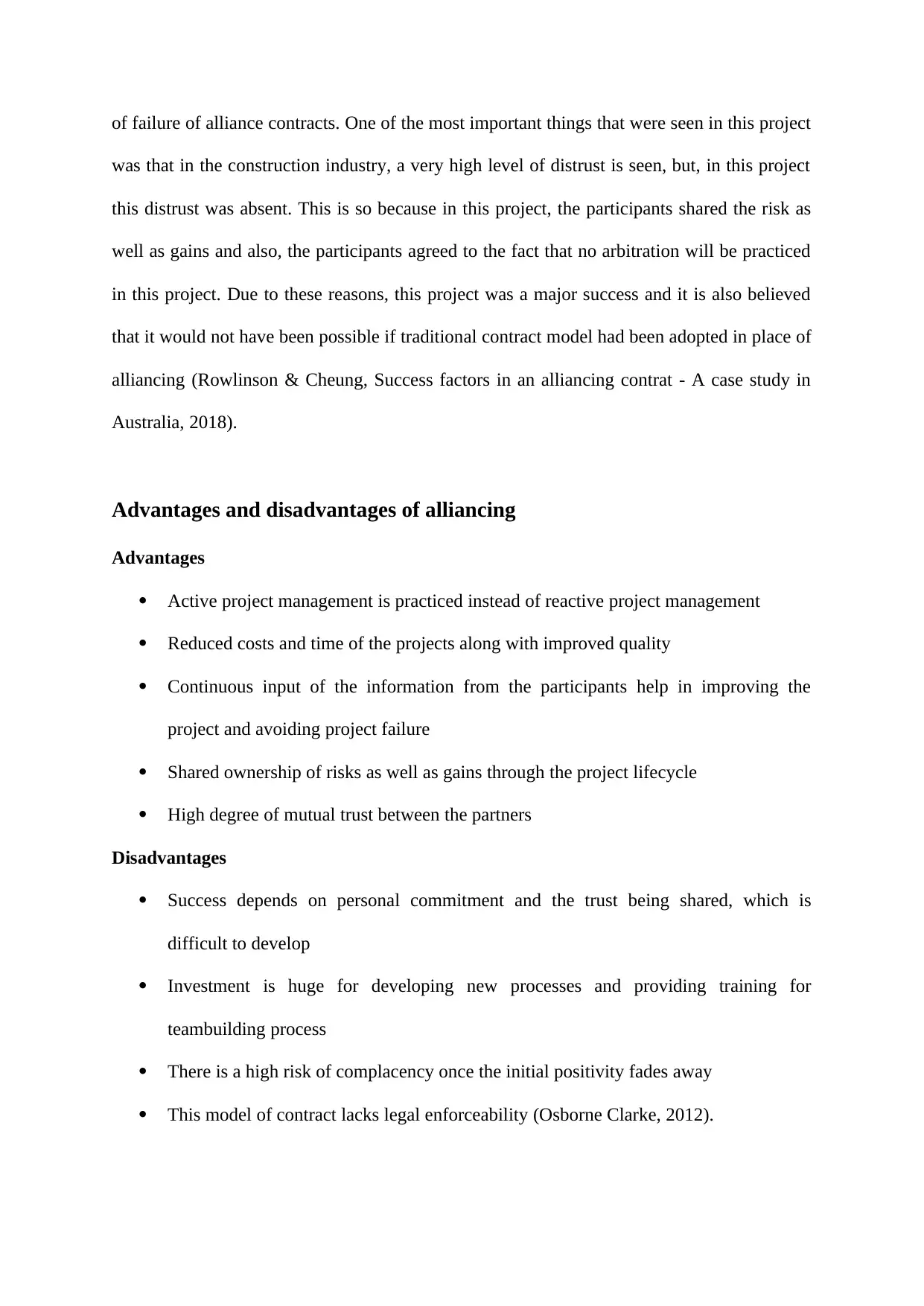
of failure of alliance contracts. One of the most important things that were seen in this project
was that in the construction industry, a very high level of distrust is seen, but, in this project
this distrust was absent. This is so because in this project, the participants shared the risk as
well as gains and also, the participants agreed to the fact that no arbitration will be practiced
in this project. Due to these reasons, this project was a major success and it is also believed
that it would not have been possible if traditional contract model had been adopted in place of
alliancing (Rowlinson & Cheung, Success factors in an alliancing contrat - A case study in
Australia, 2018).
Advantages and disadvantages of alliancing
Advantages
Active project management is practiced instead of reactive project management
Reduced costs and time of the projects along with improved quality
Continuous input of the information from the participants help in improving the
project and avoiding project failure
Shared ownership of risks as well as gains through the project lifecycle
High degree of mutual trust between the partners
Disadvantages
Success depends on personal commitment and the trust being shared, which is
difficult to develop
Investment is huge for developing new processes and providing training for
teambuilding process
There is a high risk of complacency once the initial positivity fades away
This model of contract lacks legal enforceability (Osborne Clarke, 2012).
was that in the construction industry, a very high level of distrust is seen, but, in this project
this distrust was absent. This is so because in this project, the participants shared the risk as
well as gains and also, the participants agreed to the fact that no arbitration will be practiced
in this project. Due to these reasons, this project was a major success and it is also believed
that it would not have been possible if traditional contract model had been adopted in place of
alliancing (Rowlinson & Cheung, Success factors in an alliancing contrat - A case study in
Australia, 2018).
Advantages and disadvantages of alliancing
Advantages
Active project management is practiced instead of reactive project management
Reduced costs and time of the projects along with improved quality
Continuous input of the information from the participants help in improving the
project and avoiding project failure
Shared ownership of risks as well as gains through the project lifecycle
High degree of mutual trust between the partners
Disadvantages
Success depends on personal commitment and the trust being shared, which is
difficult to develop
Investment is huge for developing new processes and providing training for
teambuilding process
There is a high risk of complacency once the initial positivity fades away
This model of contract lacks legal enforceability (Osborne Clarke, 2012).
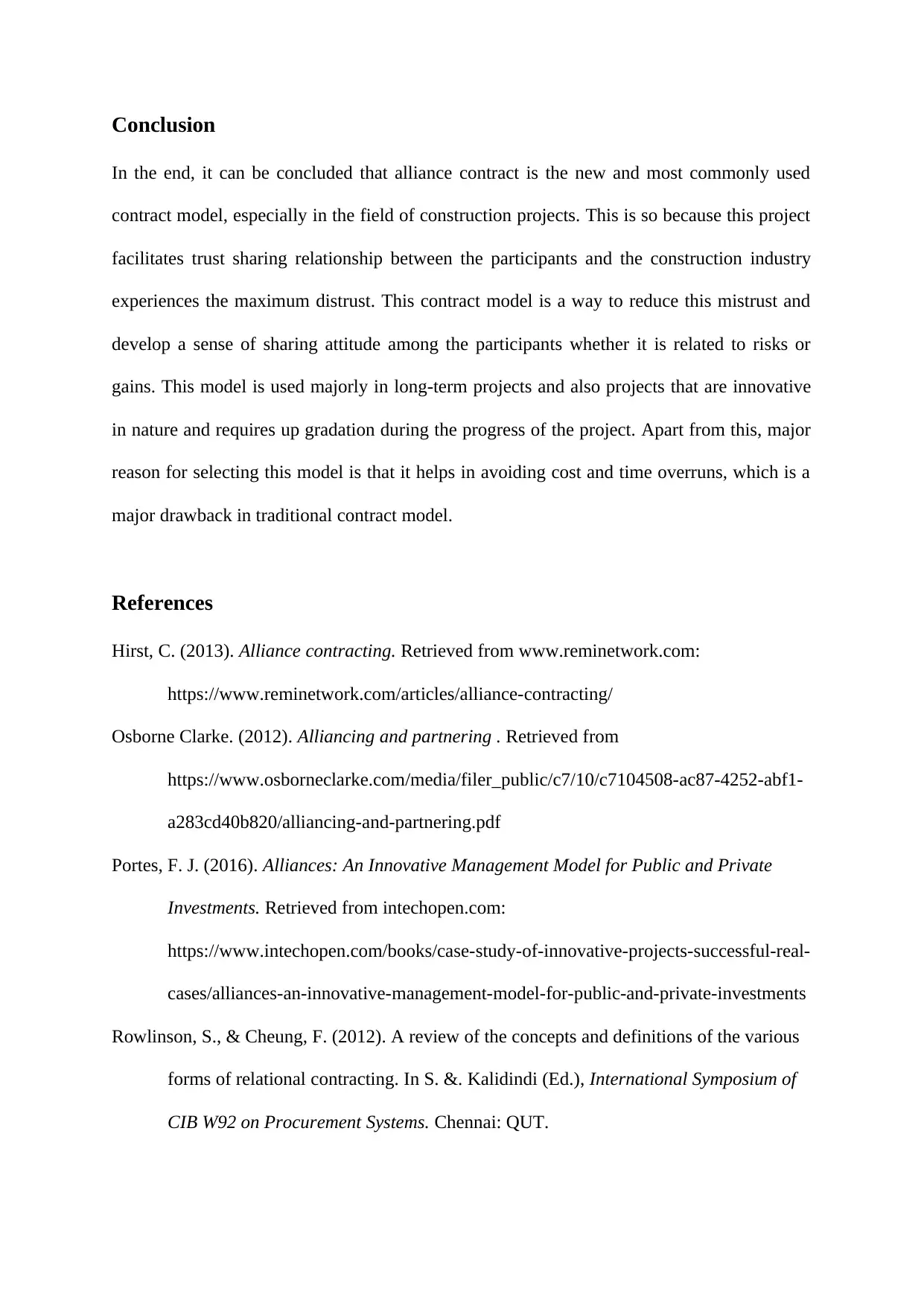
Conclusion
In the end, it can be concluded that alliance contract is the new and most commonly used
contract model, especially in the field of construction projects. This is so because this project
facilitates trust sharing relationship between the participants and the construction industry
experiences the maximum distrust. This contract model is a way to reduce this mistrust and
develop a sense of sharing attitude among the participants whether it is related to risks or
gains. This model is used majorly in long-term projects and also projects that are innovative
in nature and requires up gradation during the progress of the project. Apart from this, major
reason for selecting this model is that it helps in avoiding cost and time overruns, which is a
major drawback in traditional contract model.
References
Hirst, C. (2013). Alliance contracting. Retrieved from www.reminetwork.com:
https://www.reminetwork.com/articles/alliance-contracting/
Osborne Clarke. (2012). Alliancing and partnering . Retrieved from
https://www.osborneclarke.com/media/filer_public/c7/10/c7104508-ac87-4252-abf1-
a283cd40b820/alliancing-and-partnering.pdf
Portes, F. J. (2016). Alliances: An Innovative Management Model for Public and Private
Investments. Retrieved from intechopen.com:
https://www.intechopen.com/books/case-study-of-innovative-projects-successful-real-
cases/alliances-an-innovative-management-model-for-public-and-private-investments
Rowlinson, S., & Cheung, F. (2012). A review of the concepts and definitions of the various
forms of relational contracting. In S. &. Kalidindi (Ed.), International Symposium of
CIB W92 on Procurement Systems. Chennai: QUT.
In the end, it can be concluded that alliance contract is the new and most commonly used
contract model, especially in the field of construction projects. This is so because this project
facilitates trust sharing relationship between the participants and the construction industry
experiences the maximum distrust. This contract model is a way to reduce this mistrust and
develop a sense of sharing attitude among the participants whether it is related to risks or
gains. This model is used majorly in long-term projects and also projects that are innovative
in nature and requires up gradation during the progress of the project. Apart from this, major
reason for selecting this model is that it helps in avoiding cost and time overruns, which is a
major drawback in traditional contract model.
References
Hirst, C. (2013). Alliance contracting. Retrieved from www.reminetwork.com:
https://www.reminetwork.com/articles/alliance-contracting/
Osborne Clarke. (2012). Alliancing and partnering . Retrieved from
https://www.osborneclarke.com/media/filer_public/c7/10/c7104508-ac87-4252-abf1-
a283cd40b820/alliancing-and-partnering.pdf
Portes, F. J. (2016). Alliances: An Innovative Management Model for Public and Private
Investments. Retrieved from intechopen.com:
https://www.intechopen.com/books/case-study-of-innovative-projects-successful-real-
cases/alliances-an-innovative-management-model-for-public-and-private-investments
Rowlinson, S., & Cheung, F. (2012). A review of the concepts and definitions of the various
forms of relational contracting. In S. &. Kalidindi (Ed.), International Symposium of
CIB W92 on Procurement Systems. Chennai: QUT.
⊘ This is a preview!⊘
Do you want full access?
Subscribe today to unlock all pages.

Trusted by 1+ million students worldwide
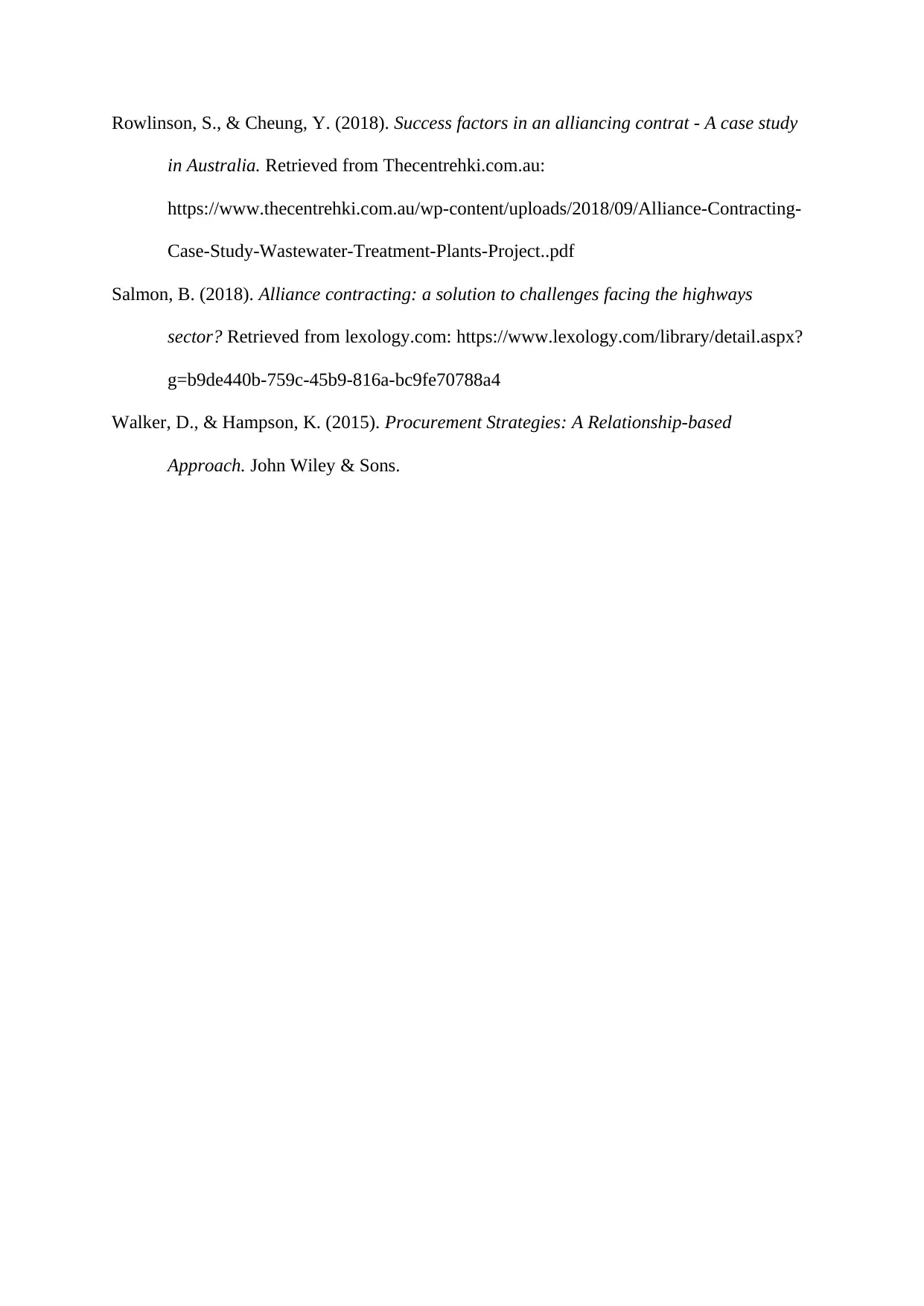
Rowlinson, S., & Cheung, Y. (2018). Success factors in an alliancing contrat - A case study
in Australia. Retrieved from Thecentrehki.com.au:
https://www.thecentrehki.com.au/wp-content/uploads/2018/09/Alliance-Contracting-
Case-Study-Wastewater-Treatment-Plants-Project..pdf
Salmon, B. (2018). Alliance contracting: a solution to challenges facing the highways
sector? Retrieved from lexology.com: https://www.lexology.com/library/detail.aspx?
g=b9de440b-759c-45b9-816a-bc9fe70788a4
Walker, D., & Hampson, K. (2015). Procurement Strategies: A Relationship-based
Approach. John Wiley & Sons.
in Australia. Retrieved from Thecentrehki.com.au:
https://www.thecentrehki.com.au/wp-content/uploads/2018/09/Alliance-Contracting-
Case-Study-Wastewater-Treatment-Plants-Project..pdf
Salmon, B. (2018). Alliance contracting: a solution to challenges facing the highways
sector? Retrieved from lexology.com: https://www.lexology.com/library/detail.aspx?
g=b9de440b-759c-45b9-816a-bc9fe70788a4
Walker, D., & Hampson, K. (2015). Procurement Strategies: A Relationship-based
Approach. John Wiley & Sons.
1 out of 7
Your All-in-One AI-Powered Toolkit for Academic Success.
+13062052269
info@desklib.com
Available 24*7 on WhatsApp / Email
![[object Object]](/_next/static/media/star-bottom.7253800d.svg)
Unlock your academic potential
Copyright © 2020–2025 A2Z Services. All Rights Reserved. Developed and managed by ZUCOL.